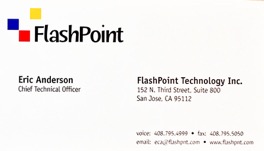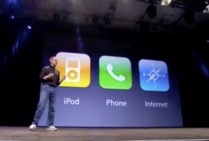A view of Lake Pend Oreille from the mountainside northwest of Sandpoint, and just west of the Airport. My home is just below this viewpoint.
Eric C. Anderson Autobiography 6
FlashPoint and Patent Litigation
FlashPoint Technology, Inc.
I was a founder at FlashPoint. FlashPoint Technology, Inc. was started officially on November 15, 1996. We grew the company to over 120 employees, with many on-going projects and customers. More than seven products were shipped with the Digita™ OE (Operating Environment) installed. The products shipped include:
- Kodak DC220 Digital Camera
- Kodak DC260 Digital Camera
- Kodak DC265 Digital Camera
- Kodak DC290 Digital Camera
- H/P C500 Digital Camera
- Minolta Dimage EX-1500 Digital Camera
- Pentax Digital Camera
- Epson Print-On PT-100 Digital Image Printer

Kodak DC220 camera, introduced in 1998 with the renamed Digita Operating Environment
Digita™ OE and Digita™ Script - Groundbreaking Tech!
Digita™ OE was a platform. By this, I mean that it provided a set of API’s on which the camera application ran. Other applications were also created, and developers were allowed to develop applications as well. It had a Graphic User Interface (see the LCD screen of the Kodak DC290 showing the menu system), and probably one of the most significant items was the ability to run Digita™ Scripts. These were application programs written in a high-level language similar to Basic that anyone could learn. It would allow fairly complex applications to be written without having to become a programmer, dealing with API’s and development tools.
For example, a script could capture a series of prompted photos from a home for a real estate agent, and generate a web page of photos and information about the property - all built-in and accessed via the 2" LCD screen and the 3 user buttons. Or, it could program the camera to capture your brother coming into your bedroom to grab some stuff (motion detection via image variations). Or, it could measure a room. Scripted capture was a really useful function, offered on cruise ships and for real estate agents and others. The script would prompt you what photos to take, and prompt you for information entry, such as names, addresses, etc., and then could format this all into a printed or web page - all in the camera!
This feature is not available even on today’s advanced models or smartphones. It is a fantastic business feature, but no one is paying attention.
Market Conditions Begin Big Changes
After shipping cameras for Kodak, Minolta, H/P, and Pentax, FlashPoint was working with several carriers on camera phones. However, the market crash of 2000-2001 badly hurt the carriers, and most camera phone projects were put on hold. FlashPoint had sadly put most of its eggs into that basket, so by March of 2001, a massive layoff took place, including me, the CTO. It was at that time I started Anderson Creations.
Later, in October 2001, I was offered a part-time remote "at home" job with FlashPoint to help them with patent litigation. This arrangement lasted until April 2016.

The Crash of 2000-2001

My business card from FlashPoint
Patent Development and Litigation
During my stay at Apple and FlashPoint, I filed over 170 patent applications. As of this writing, over 150 have issued. A list of the issued patents can be seen on my resume, available elsewhere on this website, and include DSP and audio hardware and software, digital camera and internet patents, as well as a few in other areas.
Probably the biggest deal with the patents was supporting Apple and Flashpoint in patent disputes. The biggest case was with Kodak suing Apple for $1 billion dollars for patent infringement. I was the "star" witness on that case, and it turned out that the lawyers proved to the court that Kodak had "stolen" 11 patents from Apple that were my inventions. The key $1 billion patent was thus overturned and invalidated as it did not have my name on it as the inventor. Apple got the other 10 from Kodak in a later dealing.
Steve Jobs Introduces the iPhone!
Many of my patents did not get used in Digita, but some ended up in iOS. I was so excited to finally see some of my 1993 ideas actually implemented - BY APPLE! Thank you, Steve! The most famous patent of which is the "rotating GUI" and auto-resize feature which allows you to see portrait and landscape photos in either device orientation, to have a GUI in either orientation, and of course to actually "know" the orientation of the image when captured (via the accelerometer). This was all invented for Apple Camera Architecture, originally to be shipped in 1994-1995 with Sanyo.. I still remember - during a deposition on the capture orientation patent - the stupid question: "how can you tell which way is up if you take the camera into outer space?" Duh. Or "how can you tell which way is up if the aspect ratio is 1:1?" Lawyer questions can be utterly stupid! Especially when they are truing to figure out a way to get an engineer to say something stupid. Didn’t work… :)

Steve Jobs introduces iPhone in 2007

One of several Digital ™ Script contests that FlashPoint ran with our partners. The customers always surprised us. I had told several customers that there was no way to detect motion and capture just the photo of something happening, but one of our customers won the prize by doing exactly that!
Copyright © 2017 Anderson Creations. All Rights Reserved.




